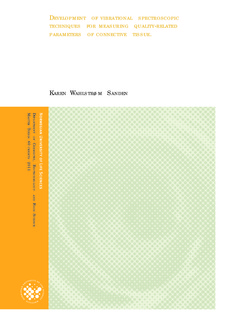| dc.description.abstract | The aim of this work was to study by Fourier-transform infrared (FT-IR) micro spectroscopy different parameters of connective tissue, which have previously been related to meat tenderness. These parameters were collagen fiber orientations, collagen and sulfated
glycosamineoglycans (GAGs) content, and their relative ratio during storage. Two different bovine muscles were studied, M. psoas major (PM) and M. Semitendinosus (ST). These muscles are known to differ in tenderness, with the PM muscle as the most tender. The muscles were aged at 4º for 19 days and samples were taken for spectroscopic, biochemical and histological analysis every third day. Mechanical measurements (Warner Bratzler) were
done to confirm the textural properties in the two muscles. Biochemical measurement by DMB and histological staining by Alcian blue were used to verify the content and distribution of sulfated GAGs in the two muscles during aging. The tissue sections were also stained with collagen I antibodies to see the distribution of collagen in the connective tissue in the two muscles.
The tissue section was measured by (FT-IR) micro spectroscopy using single spectra and
polarized light microscopy imaging. The absorbance peaks obtained from single spectra were related to the connective tissue parameters, and the polarized measurement was used to investigate the direction of the collagen fibers in the connective tissue. The sulfate stretch band at 1237 cm-1 in the infrared spectrum showed a decrease in sulfated GAGs in both muscles during storage, in accordance with biochemical and histological results. The ST muscle had a higher content of sulfated GAGs and had a more pronounced
decrease measured biochemically, and the same result were also obtained in the spectra. The collagen absorption band at 1659 cm-1showed a possible degradation of cross-links in the PM muscle, however, using a different cross-links ratio (1660:1690) no difference were found. The absorbance at 1654 cm-1 could indicate a conformation change in the collagen α-
helix in the PM muscle. Two bands in the water region were assigned to hydrogenated and non-hydrogenated N-H starching bands at ~3290 and ~3335 cm-1 respectively. These water bands could be used to estimate the hydrogenation of connective tissue proteins and shows
that the water content in the samples is decreasing during storage. The polarized measurements showed that the collagen fibers in the PM muscle had a random
orientation, while fibers in the ST muscle showed an orientation parallel to the x- axis early in the period and a random orientation after 11 days post mortem storage. Staining with antibodies against collagen I supported these results, showing that the perimysium of PM had III
a more diffuse staining pattern compared to the ST muscle which showed a more wavy
appearance with clear thread-like like structures. Our results from this study show that FT-IR micro spectroscopy is promising in evaluating connective tissue in bovine skeletal muscles. Good correlation between the spectroscopic measurement due to the biochemically and histological methods was obtained. Målet med dette arbeidet var å studere ulike parametre av bindevev med Fourier-transform infrarød (FT-IR) spektroskopi. Disse parametrene er kollagen fiber orientering, kollagen og sulfaterte glykosamineoglykaner (GAGs) mengde, og deres relative ratio under lagring. To ulike bovine muskler ble studert, indrefilet (M. psoas major, PM) og lårtunge (M. semitendinosus, ST). Disse musklene varierer i mørhet, der indrefilet er mørest. Musklene ble lagret ved 4 º i 19 dager, der prøver ble tatt ut hver tredje dag til spektroskopiske, biokjemiske
og histologiske analyser. Mekanisk målinger (Warner Bratzer) ble gjort for å bekrefte tekstur egenskaper i de to musklene. Biokjemisk måling med DMB og histologisk farging med Alcian blue ble brukt til å måle innhold og detektere fordelingen av sulfaterte GAGs i de to
musklene under lagring. Prøvene ble også farget med kollagen I antistoffer for å se
distribusjonen av kollagen I i bindevevet i de to musklene. Prøvene ble målt med FT-IR mikro spektroskopi og ved hjelp av både enkelt spektra og polarisert lysmikroskopi avbilding. Absorbans topper ble analysert i forhold de ulike bindevevsparameterne. De polarisert målingen ble brukt til å undersøke retningen av kollagen fibrene i bindevevet. Absorbans topp ved 1237 cm-1 viste en nedgang i sulfaterte GAGs i begge muskler under lagring, dette i samsvar med biokjemiske og histologiske resultater. Lårtunge hadde et høyere innhold av sulfaterte GAGs enn indrefilet. Lårtunge hadde også en mer markant nedgang som
ble sett både i de biokjemiske resultatene og i spektrene. Absorpsjon av collagen ved 1659 cm-1 viste en mulig degradering av kryssbindinger i indrefilet, men ved bruk av en annen kryssbinding ratio (1660:1690) ble ingen forskjell funnet. Absorbansen ved 1654 cm-1 kan indikere en konformasjon endring i kollagen α-helix i indrefilet. To band i vannet regionen viste hydrogenert og ikke-hydrogenert N- H strekk, på
henholdsvis ~ 3290 og ~ 3335 cm-1. Disse vann toppene kan brukes til å beregne
hydrogenering av bindevevs proteiner og det viser at musklene mister vann gjennom lagring. De polariserte målingene viste at kollagen fibrene i indrefilet hadde en tilfeldig orientering, mens fibre i lårtunge viste en orientering parallelt med x-aksen tidlig i perioden, og en tilfeldig orientering etter 11 dagers lagring.. Farging med antistoffer mot kollagen I støttet
disse resultatene, viser en mer tydelig kollagen orientering med ”trådlike” strukturer. Våre resultater fra denne studien viser at FT-IR mikro spektroskopi er lovende i evaluering av bindevevs komponenter i bovine skjelett muskler. Det var god korrelasjon mellom de
spektroskopiske og biokjemiske målingene. | en_US |
